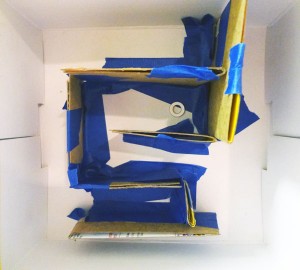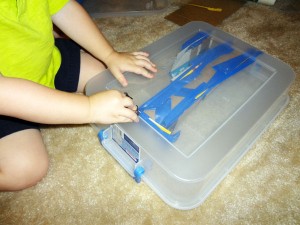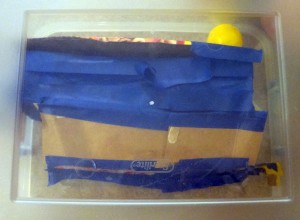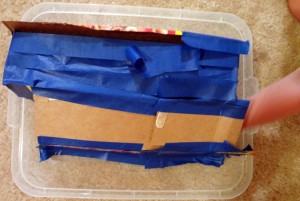A Hidden Maze
Today Trisha from Inspiration Laboratories is here. Trisha won me over with What Can You Learn from a Cardboard Tube? (the truth is she won me over long before that post… but it is one of my favorites!) I bet she has something equally amazing today. ENJOY….
If you hide a maze inside a box, can you still find your way through it?
Here’s what you need to try this:
- an opaque box (I used a shoe box) with a lid
- cardboard scraps – cereal boxes work well
- tape
- something metal to travel through the maze (metal balls or washers work well – be sure the metal you choose is magnetic)
- a magnet (You may need to test the strength of the magnet to see if it can move your metal ball or washer through the box. You can also use two magnets.)
Setup:
- Create a maze inside the box. Tape pieces of cardboard vertically to create the walls of the maze. You can make it as simple or as complex as you like.
- Place one or more metal balls or washers inside the box. (Be careful of small parts if you have little ones.)
- Put the lid on the box. (You may want to seal the lid if you have someone that will be tempted to open it.)
Next Steps:
It will depend on your child where you would like to start in this exploration process. Do what works for him/her.
- Hand the box to your child and let him/her explore it (moving it, turning it, shaking it, etc.).
- Ask: What do you think the inside of the box looks like? What is in the box?
- Ask: How do you think we can determine what the inside looks like without opening it?
- Try out some ideas. Draw pictures of what you think it looks like.
Tell you child there is a maze inside the box. The goal is to draw the maze. You have placed a metal ball/washer inside the box to help figure it out. (Ask how the metal can help and what else they might need.)
- Have your child place the magnet on the outside of the box and search for the metal ball/washer.
- Move the ball/washer through the maze.
- Draw a picture of the inside of the box.
- How can you tell where the maze walls are?
- How does the magnet help you find the walls?
- What happens when you move the magnet over the box? (It should feel like it hits a wall or some resistance when the ball/washer runs into the maze wall. The magnet may even release from the box.)
Modifications for Younger Children
- Create a maze inside a clear box. Help your child use the magnet to pull the metal ball/washer through the maze.
- Create a maze inside a clear box. Place a ball inside the box. Show your child how to tilt the box to get the ball through the maze from one side to the other.
- Create a maze in a box without a lid (or just on top of a lid). Add tunnels. Allow your child to move the ball through the maze.
- Place different sounding objects in various boxes or containers and allow your child to shake and explore them. The containers can be clear so they can see the objects that are making the sound. Or you can place the sound makers in opaque containers to add a bit more mystery to the sounds and to focus on senses other than sight.
The Science Behind It
This activity promotes observation and inference skills. An observation is made with one or more of your five senses; it is something you can directly measure. An inference is based on observations and data that is collected, but is not directly observable. Saying that someone looks tired is an inference. You observe what the person looks like and how they behave. Your observations lead you to conclude the person is tired. Inferences are made in science all of the time – when studying behavior in animals, when discussing the solar system, when describing the structure of our planet, etc. Inferences are important in helping us understand and describe the world around.
Trisha blogs at Inspiration Laboratories about her adventures with her son, Aiden. She is an educator with a passion for science literacy. It is never too early to start encouraging science learning (or any kind of learning for that matter). Trisha believes in encouraging learning through creativity and play.







Love this idea! I think both of my kids will enjoy it and not even realize my educational agenda!
This is so cool! What a creative way to strengthen science concepts.
I was so excited when I read this post. She did a brilliant job of laying out the science concept. Glad you liked it too!
Fun. Inference is a difficult skills to teach but so necessary. This is a great way to do it in a fun scientific way. Now to find a box!
I could not agree more! Trisha did a fantastic job of bringing a fun activity to an entire new level. I’m in search of a box too!
I just want to run out and grab a few shoe boxes! I was glad to she included questions you could ask the child. I find so many “cute” activities but sometimes parents and educators fail to go further and ask questions that promote thinking strategies. Nicely done:)
I absolutely agree Deborah. I often find myself at a loss when it comes to science. I really appreciate a post that goes into detail about the learning aspect.